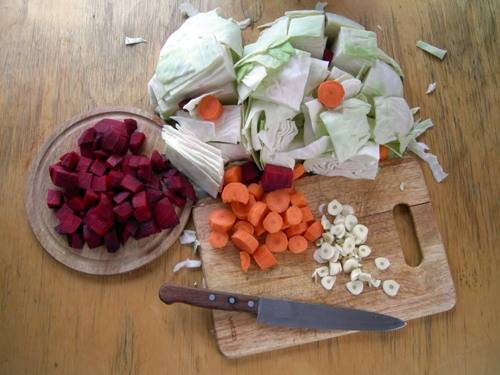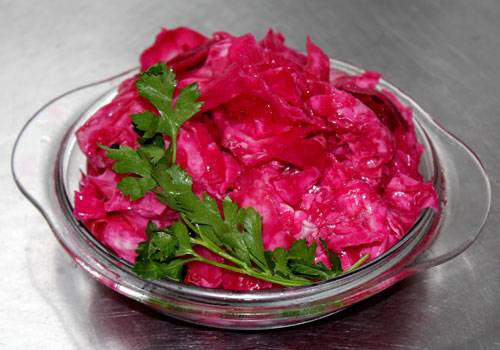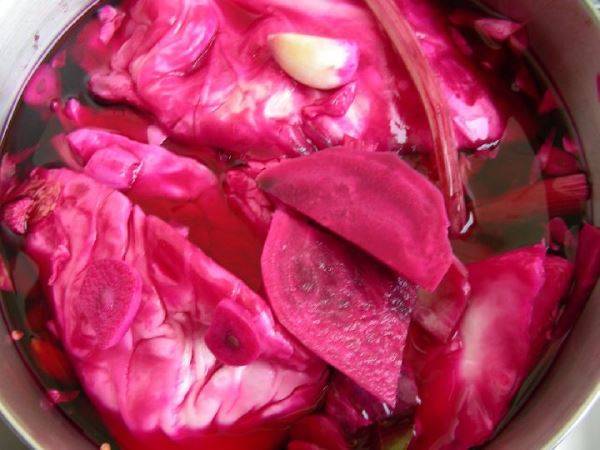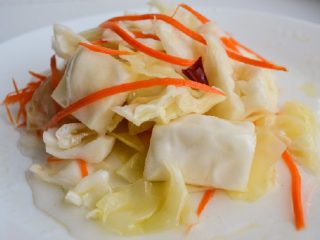It would seem how it is possible to improve the recipe for sauerkraut or pickled cabbage if this delicious salad appetizer has been prepared in Russia from time immemorial and no other people can boast of an equally reverent attitude towards this vegetable. But it turns out that it is also useful to adopt the experience of other peoples. Namely, the Georgians were the first to think of adding beets when salting cabbage. And the result is a dish that is hard to come up with in terms of beauty. And thanks to the use of traditional Georgian spicy herbs and hot peppers, the taste of cabbage prepared according to this recipe is able to conquer any spicy snack lover for a long time.
Classic recipe for making pickled cabbage with beets in Georgian, or in Gurian, as it is sometimes called, does not involve the use of vinegar. Fermentation takes place in the most natural way, but lasts for quite a long time, at least 5-7 days. For those who would like to enjoy this delicacy as soon as possible, there is another recipe using vinegar - this article lists both of these most popular options.
Time-tested classics
If we talk about the main components, then in the classic version there are not so many of them.
The main ingredients you need to find are:
- White cabbage - 3 kg;
- Beets - 1.5 kg;
- Leaf celery - 1.5-2 bunches;
- Garlic - 2 heads;
- Hot pepper - 1-4 pods;
- Water - 2.5 liters;
- Salt - 3 tablespoons.
Additional ingredients:
- Granulated sugar - 1 tablespoon;
- Allspice - 5-6 peas;
- Bay leaf - 3-4 pieces;
- Cilantro - 1 bunch;
- Coriander - 1-2 teaspoons of seeds;
- Parsley - 1 bunch;
- Basil - 1 bunch.
When choosing a cabbage, fix your gaze on small, sturdy heads of cabbage. If you use large heads of cabbage, chances are good that they will crumble when you marinate them. And an additional aesthetic component of this recipe consists precisely in small dense pieces of cabbage. You need to choose ripe, juicy beets that give off their color well. Garlic can be any, but without visible damage.
Heads of cabbage are cut into 6-8 pieces in order to get neat dense pieces... Beets are best cut into thin slices with a peeler. Then it will be possible to feast on beets on a par with the cabbage itself - they are so tasty in the finished dish. Use hot peppers to your liking - if you are not a big fan of spicy dishes, then just one pod is enough. Cut the pepper into strips or thin rings. Garlic should not be chopped too much. Having cleaned the cloves from the outer husk, cut each clove into 2-4 parts.
Celery can not be chopped, but only divided into twigs.
It is better to prepare the brine for pouring in advance, since according to the recipe it must be used cold. Dissolve the salt in water, heat and then cool.
From the amount of vegetables specified in the recipe, about 6 liters of the finished dish is obtained. Based on this, prepare an enamel container of a suitable size and start laying the sliced vegetables in it in layers.First, pieces of cabbage are put, they are covered with slices of beets, then they are sprinkled with pieces of garlic and hot pepper, and finally a couple of celery sprigs are placed. This sequence is repeated as many times as you have enough harvested vegetables. From the very top, there must be a layer of beets.
If the brine is cold, then carefully pour the vegetables laid in layers with it, lightly press them on top so that they are completely immersed in the brine. Then close the pot with a lid and leave in normal room conditions for 3 days. After the allotted time, open the lid and taste the brine. If desired, add more salt to the pan on top and stir it a little. On the fifth day, you can already try cabbage and other vegetables and remove the pan with it to a cooler place.
But as a rule, pickled cabbage fully gains its taste and aroma after another 2 days. Such a blank can be stored for up to several months in the refrigerator.
Fast food recipe
Of course, in the cabbage prepared according to the previous recipe, all vitamins and other useful substances found in vegetables and herbs used for pickling are preserved and even multiplied to the maximum. But sometimes there are situations when it is necessary to quickly cook Georgian cabbage with beets and then the recipe below comes to the rescue.
It is important to keep only the exact proportions of the content of cabbage and beets, 1.5 kg of beets are taken for 3 kg of cabbage. You can afford to experiment with the rest of the vegetables and herbs, but according to the recipe, their composition should be as follows:
- Garlic - 2 heads;
- Celery - 2 bunches;
- Kinza, Parsley - 1 bunch each;
- Hot red pepper - 2 pods;
- Carrots - 0.5 kg;
- Sweet pepper - 0.5 kg.
All vegetables are selected and cut in exactly the same way as in the previous version. It is best to grate the carrots on a Korean grater, and coarsely chop the greens.
The main difference will be in the preparation of the marinade. According to the recipe, for 2.5 liters of water, 100 g of salt, 60 g of sugar, half a teaspoon of coriander seeds, a few allspice peas, as well as black pepper and 3-4 bay leaves are added. Everything is heated to a boil, removed from heat and 2-3 tablespoons of apple or wine vinegar are added to the marinade.
The marinade can be cooled somewhat and poured over the vegetables and herbs laid in layers. The cabbage made in this way is kept in a warm room for 24 hours, and then placed in a cool place. In a day, Georgian cabbage with beets can be tasted, and in 2-3 days it will be completely ready.
Cabbage prepared according to these recipes must be kept in the marinade so that it completely covers it in a cool place. Although, as practice shows, such cabbage does not stale for a long time and even significant quantities of it are eaten very quickly.













